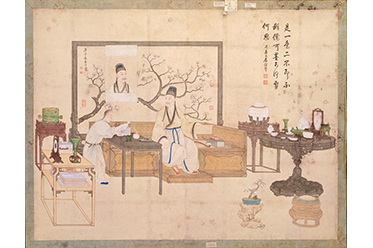 Hidden treasures from Beijing’s Palace Museum in the Forbidden City will come to Melbourne for the first time, in an Australian exclusive exhibition at the National Gallery of Victoria from 27 March 2015.
Hidden treasures from Beijing’s Palace Museum in the Forbidden City will come to Melbourne for the first time, in an Australian exclusive exhibition at the National Gallery of Victoria from 27 March 2015.
A Golden Age of China: Qianlong Emperor (1736–1795) tells the story of China’s foremost art collector Qianlong Emperor, one of China’s most successful rulers and fourth and longest living emperor of the Qing dynasty (1644-1911).
This exhibition provides an unprecedented opportunity to explore a rich concentration of more than 120 works from the Palace Museum’s art collection, which is built on the imperial collection of the Ming and Qing dynasties and holds some of China’s most rare and valuable works of art in its collection.
“This exhibitions tells the fascinating narrative of one of China’s most influential rulers and a great champion of the arts, whose passion saw him become one of China’s foremost collectors and conservators of art,” says Tony Ellwood, Director NGV.
“It is a once in a lifetime opportunity to see exquisite works from Beijing’s Palace Museum in Australia and visitors will be able to see stunning ink on silk paintings, dragon-embroidered silk court robes, precious objet d’art in gold and jade, as well as Qianlong’s own paintings and calligraphy.”
The Qianlong emperor’s long 60-year reign (1736-1795) was a particularly fascinating time in China’s history. During his reign, China was the wealthiest and most populous nation in the world. Qianlong’s ability to preserve and foster his Manchu warrior-huntsman traditions whilst adopting the Confucian principles of political and cultural leadership, resulted in the successfully governing of 150 million Chinese people.
It was his ability to adopt Chinese ways, yet honour his Manchu traditions that made him one of the most successful emperors of the Qing dynasty. The Qianlong Emperor studied Chinese painting, loved to paint and particularly loved to practice calligraphy.
The Emperor was also a passionate poet and essayist and over 40,000 poems and 1300 pieces of prose are recorded in his collected writings. Qianlong wrote more poetry in his lifetime than all the poets in the Tang dynasty (618-906) combined, a dynasty known for its Golden age of poetry.
Aside from his own art practice, Qianlong combined his passion for collecting art with his role as preserver and restorer of the Chinese cultural heritage. He also embraced the arts of other cultures, European, Japanese and Indian. Giuseppe Castiglione, an Italian Jesuit brother, exerted a great deal of influence in the arts of the court academy of the Qianlong emperor.
The exhibition will put the spotlight on Qianlong’s reign and art in five separate sections; Manchu Emperor, Son of Heaven, Imperial Art under the Patronage of the Emperor, Imperial Art of Religion and Chinese Scholar, the Foremost Art Connoisseur and Collector.
Visitors will enjoy a lavish display of paintings in silk and paper, silk court robes, precious-stone inlayed objet d’art and portraits of the Qianlong emperor, empress and imperial concubines; paintings of hunting scenes, court ceremonies and private lives of the Qianlong emperor and paintings of the emperor as scholar and art collector.
The exhibition will also show paintings and calligraphy by the emperor himself as well as classical paintings in his collection. There will also be a sumptuous display of ceremonial weapons of swords, bows and arrow, a chair made of antlers’ horns; silk court robes and ceremonial hats, amongst other ceremonial and palace treasures.
There will be a sensory element within the exhibition, complete with music and Forbidden City-like interiors, immersing visitors in a day in the life of Qianlong, to evoke the experience of the imperial court. Qianlong Emperor uncovers the richness of Chinese history and culture, and reveals the human interests of a governing emperor.
“A Golden Age of China will give visitors a fascinating insight into an era of China’s cultural history that resonates across the world to this day,” said Minister for Creative Industries, Martin Foley.
“The Victorian Government is grateful to the Palace Museum for entrusting the NGV with its treasures as part of a ground-breaking partnership between the two institutions. The exhibition comes here as a result of the strong contemporary relationship between China and Victoria.”
A Golden Age of China: Qianlong Emperor (1736–1795)
NGV International, St. Kilda Road, Melbourne
Exhibition: 27 March – 21 June 2015
Entry fees apply
For more information, visit: www.ngv.vic.gov.au for details.
Image: QIANLONG EMPEROR, Chinese 1711–99, CHINESE (court artists) Qianlong Emperor appraising: One or two Qing dynasty, Qianlong period 1736–95, screen painting painted and signed by Qianlong Emperor in the summer of 1780 and with two seals of the Qianlong Emperor, also inscribed with poem by Qianlong Emperor coloured inks on silk 92.2 x 121.5 cm (image) The Palace Museum, Beijing (Gu6492)
